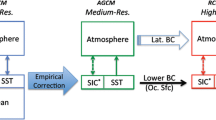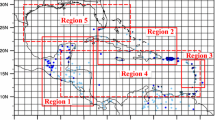Abstract
Three 30 year long simulations have been performed with a T42 atmosphere model, in which the sea-surface temperature (SST) and sea-ice distribution have been taken from a transient climate change experiment with a T21 global coupled ocean-atmosphere model. In this so-called time-slice experiment, the SST values (and the greenhouse gas concentration) were taken at present time CO2 level, at the time of CO2 doubling and tripling.
The annual cycle of temperature and precipitation has been studied over the IPCC regions and has been compared with observations. Additionally the combination of temperature and precipitation change has been analysed. Further parameters investigated include the difference between daily minimum and maximum temperature, the rainfall intensity and the length of droughts.
While the regional simulation of the annual cycle of the near surface temperature is quite realistic with deviations rarely exceeding 3 K, the precipitation is reproduced to a much smaller degree of accuracy.
The changes in temperature at the time of CO2 doubling amount to only 30–40% of those at the 3 * CO2 level and show hardly any seasonal variation, contrary to the 3 * CO2 experiment. The comparatively small response to the CO2 doubling can be attributed to the cold-start of the simulation, from which the SST has been extracted. The strong change in the seasonality cannot be explained by internal fluctuations and cold start alone, but has to be caused by feedback mechanisms. Due to the delay in warming caused by the transient experiment, from which the SST has been derived, the 3 * CO2 experiment can be compared to the CO2 doubling studies performed with mixed-layer models.
The precipitation change does not display a clear signal. However, an increase of the rain intensity and of longer dry periods is simulated in many regions of the globe.
The changes in these parameters as well as the combination of temperature- and precipitation change and the changes in the daily temperature range give valuable hints, in which regions observational studies should be intensified and under which aspects the observational data should be evaluated.
Similar content being viewed by others
References
Arpe, K., Bengtsson, L., Dümenil, L., and Roeckner, E.: 1994, ‘The Hydrologic Cycle in the ECHAM3 Simulations of the Atmospheric Circulation’, in Desbois, M., Desalmond, E. (eds.),Global Precipitation and Climate Change, Vol. I,26, 361-377.
Bardossy, A. and Plate, E. J.: 1992, ‘Space-Time Models for Daily Rainfall Using Atmospheric Circulation Pattern’,Water Resource Res. 28, 1247–1259.
Begntsson, L., Arpe, K., Roeckner, E., and Schulzweida, U.: 1994,Climate Predictability Experiments with a General Circulation Model, Report No. 145, Max-Planck-Institut für Meteorologie, Bundesstr. 55, Hamburg, Germany.
Bengtsson, L., Botzet, M., and Esch, M.: 1994,Will Greenhouse Gas-Induced Warming over the Next 50 Years Lead to Higher Frequency and Greater Intensity of Hurricanes?, Report No. 139, Max-Planck-Institut für Meteorologie, Bundesstr. 55, Hamburg, Germany.
Brinkop, S.: 1991,Inclusion of Cloud Processes in the ECHAM PBL Parameterization, Large Scale Atmospheric Modelling Rep. No. 9, 5-14, Met. Inst. Univ. Hamburg, Germany.
Bradzil, R., Budikova, M., Auer, I., Boehm, R., Cegnar, T., Fasko, P., Gajic-Capka, M., Koleva, E., Lapin, M., Niedzwiedz, T., Szalai, S., Ustrnul, Z., Weber, R. O., and Zaninovic, K.: 1995, ‘Trends of Maximum and Minimum Daily Temperatures in Central and Southeastern Europe - Natural Variability or Greenhouse Gas Signal?’, submitted toInt. J. Climatol.
Bùcher, A. and Dessens, J.: 1991, ‘Secular Trends of Surface Temperature at an Elevated Observatory in the Pyrenees’,J. Clim. 4, 859–868.
Cao, H. X., Mitchell, J. F. B., and Lavery, J. R.: 1992, ‘Simulated Diurnal Range and Variablity of Surface Temperature in a Global Climate Model for Present and Doubled CO2 Climates’,J. Clim. 5, 920–943.
Claussen, M. and Esch, M.: 1992,BIOMES Computed from Simulated Climatologies, Report No. 89, Max-Planck-Institut für Meteorologie, Bundesstr. 55, Hamburg, Germany.
Cubasch, U.: 1985, ‘The Mean Response of the ECMWF Global Model to the El Niño Anomaly in Extended Range Prediction Experiments’,Atmosphere-Ocean 23, 43–66.
Cubasch, U., Hasselmann, K., Höck, H., Maier-Reimer, E., Mikolajewicz, U., Santer, B. D., and Sausen, R.: 1992, ‘Time-Dependent Greenhouse Warming Computations with a Coupled Ocean-Atmosphere Model’,Clim. Dynam. 8, 55–69.
Cubasch, U., Santer, B.D., Hellbach, A., Hegerl, G.C., Höck, H., Maier-Reimer, E., Mikolajewicz, U., Stössel, A., and Voss, R.: 1994, ‘Monte Carlo Climate Change Forecasts with a Global Coupled Ocean-Atmosphere Model’,Clim. Dynam. 10, 1–19.
Cubasch, U., Hegerl, G., Hellbach, A., Höck, H., Mikolajewicz, U., Santer, B. D., and Voss, R.: 1995, ‘A Climate Change Simulation Starting 1935’,Clim. Dynam. 11, 71–84.
DKRZ: 1993,The ECHAM3 Atmospheric General Circulation Model, Techn. Rep. No. 6, DKRZ, Budensstr. 55, Hamburg, Germany.
Dümenil, L. and Todini, E.: 1992, ‘A Rainfall-Runoff Scheme for Use in the Hamburg GCM’,EGS Series on Hydrol. Sc. 1, 129–157.
Fichefet, T. and Tricot, C.: 1992, ‘Influence of the Starting Date of Model Integration on Projections of Greenhouse-Gas Induced Cliamte Change’,Geophys. Res. Lett. 19, 1771–1774.
Giorgi, F. and Mearns, L.: 1991, ‘Approaches to the Simuylation of Regional Climate Change: A Review’,J. Geophys. Res. 29, 191–216.
Gleckler, P. J., Randall, D. A., Boer, G., Colmann, R., Dix, M., Galin, V., Helfand, M., Kiehl, J., Kitho, A., Lau, W., Liang, XZ., Lykossov. B., McAvaney, B., Miyakoda, L., and Planton, S.: 1994, ‘Cloud-Radiative Effects on Implied Oceanic Energy Transports as Simulated by Atmospheric General Circulation Models’, PCMDI Report No. 15, PCMDI/LLNL, Livermore, Ca., U.S.A.
Grotch, S. L. and McCracken, M. C.: 1991, ‘The Use of General Circulation Models to Predict Regional Climate Change’,J. Clim. 4, 286–303.
Hansen, J., Sato, M., and Ruedy, R.: 1994, ‘Long-Term Changes of Diurnal Temperature Cycle: Implications about Mechanisms of Global Climate Change’, in: Kukla, G.et al. (eds.),Asymmetric Change of Daily Temperature Range, DOE Conf-9309350.
Hasselmann, K., Sausen, R., Maier-Reimer, E., and Voss, R.: 1992, ‘On the Cold Start Problem in Transient Simulations with Coupled Ocean-Atmosphere Models’,Clim. Dynam. 9, 53–61.
Hense, A., Kerschgens, M., and Raschke, E.: 1982, ‘An Economical Method for Computing Radiative Transfer in Circulation Models’,Quart. J. Roy. Met. Soc. 108, 231–252.
IPCC: 1990,Climate Change: The IPCC Scientific Assessment, Houghton, J., Jenkins, G. J., and Ephraums, J. J. (eds.), Cambridge University Press, 364 pp.
IPCC: 1992,Climate Change: The Supplementary Report to the IPCC Scientific Assessment, Houghton, J., Callendar, B. A., and Varney, S. K. (eds.), Cambridge University Press, 198 pp.
Kaas, E. and Frich, P.: 1994, ‘DTR and Cloud Cover over the Nordic Countries: Observed Trends and Estimates for the Future’, in Kukla, G.et al. (eds.),Asymmetric Change of Daily Temperature Range, DOE Conf-9309350.
Karl, T., Jones, P. D., Knight, R. W., Kukla, G., Plummer, N., Rzuvaev, V. N., Gallo, K. P., Lindesay, J., and Charlson, R. J.: 1993, ‘Asymmetric Trends of Daily Maximum and Minimum Temperature’,Bull. Am. Meteor. Soc. 74, 1007–1023.
Karl, T. R., Knight, R. W., and Plummer, N.: 1995, ‘Are Temperatures Becoming More Variable and Precipitation More Extreme’,Review Nature. Karl, T. R., Wang, W.-C., Schlesinger, M. E., and Knight, R. W.: 1990, ‘A Method of Relating General Circulation Model Simulated Climate to the Observed Local Climate, Part I: Seasonal Statistics’,J. Clim. 3, 1053–1079.
Kukla, G., Karl, T. R., and Riches, M. R. (eds.): 1994,Asymmetric Change of Daily Temperature, Proceedings of the MINIMAX workshop, College Park, Maryland, DOE report GCR, CONF-9309350.
Lal, M., Cubasch, U., and Santer, B. D.: 1994, ‘Effect of Global Warming on Indian Monsoon Simulated with a Coupled Ocean-Atmosphere General Circulation Model’,Current Sc. 66, 430–48.
Legates, D. R. and Willmott, C. J.: 1990a, ‘Mean Seasonal and Spatial Variability in Gauge Corrected Global Surface Air Temperature’,J. Climatol. 41, 11–21.
Legates, D. R. and Willmott, C. J.: 1990b, ‘Mean Seasonal and Spatial Variability in Gauge Corrected Global Precipitation’,J. Climatol. 10, 111–127.
Lohmann, U., Sausen, R., Bengtsson, L., Cubasch, U., Perlwitz, J., and Roeckner, E.: 1993, ‘The Köppen Climate Classification as a Diagnostic Tool for General Circulation Models’,Clim. Res. 3, 177–193.
Louis, J. F.: 1979, ‘A Parametric Model of Vertical Eddy Fluxes in the Atmosphere’,Boundary Layer Meteorol. 17, 187–202.
Mahfouf, J. F., Cariolle, D., Royer, J.-F., Geleyn, J.-F., and Timbal, B.: 1994, ‘Responses of the Meteo-France Climate Model to Changes in CO2 and Sea Surface Temperature’,Clim. Dynam. 9, 345–362.
Miller, M. J., Palmer, T. N., and Swinbank, R.: 1989, ‘Parameterization and Influence of Sub-Grid Scale Orography in General Circulation and Numerical Weather Prediction Models’,Met. Atm. Phys. 40, 84–109.
Parey, S.: 1994,2 * CO 2 and 3 * CO 2 Time Slice Experiments. Change in Mean and Variability -19th General Assembly of the European Geophysical Society - Grenoblè, April 1994.
Perlwitz, J., Cubasch, U., and Roeckner, E.: 1994,Simulation of Greenhouse Warming with the ECHAM3 Model Using the Time-Slice Method, Report, Max-Planck-Institut für Meteorologie, Bundesstr. 55, Hamburg, Germany, (in preparation).
Plummer, N., Lin, Z., and Torok, S.: 1994, ‘Recent Changes in the Diurnal Temperature Range over Australia’, in: Kukla, G.et al. (eds),Asymmetric Change of Daily Temperature Range, DOE Conf-9309350.
Roeckner, E., Arpe, K., Bengtsson, L., Brinkop, S., Dümenil, L., Esch, M., Kirk, E., Lunkeit, F., Ponater, M., Rockel, B., Sausen, R., Schlese, U., Schubert, S., and Windelband, M.: 1992,Simulation of the Present-Day Climate with the ECHAM Model: Impact of Model Physics and Resolution, Report No. 93, Max-Planck-Institut für Meteorologie, Bundesstr. 55, Hamburg, Germany.
Rockel, B., Raschke, E., and Weynes, B.: 1991, ‘A Parameterization of Broad Band Radiative Transfer Properties of Water, Ice and Mixed Clouds’,Beitr. Phys. Atmos. 64, 1–12.
Santer, B. D., Cubasch, U., Mikolajewicz, U., and Hegerl, G.: 1993,The Use of General Circulation Models in Detection Climate Change Induced by Greenhouse Gases, PCMDI Report No. 10, PCMDI/LLNL, Livermore, Ca., U.S.A.
Santer, B. D., Brüggemann, W., Cubasch, U., Hasselmann, K., Maier-Reimer, E., and Mikolajewicz, U.: 1994, ‘Signal-to-Noise Analysis of Time-Dependent Greenhouse Warming Experiments. Part 1: Pattern Analysis’,Clim. Dynam. 9, 267–285.
Schlesinger, M. E. and Mitchell, J. F. B.: 1987, ‘Climate Model Simulations of the Equilibrium Response to Increased Carbon Dioxide’,Rev. Geophys. 25, 760–798.
Tiedtke, M.: 1989, ‘A Comprehensive Mass Flux Scheme for Cumulus Parameterization in Large-Scale Models’,Mon. Wea. Rev. 117, 1779–1800.
Verdecchia, M., Visconti, G., Giorgi, F., and Marinucci, M. R.: 1994, ‘Diurnal Temperature Range for a Doubled Carbon Dioxide Concentration Experiment: Analysis of Possible Physical Mechanisms’,Geophys. Res. Let. 21, 1527–1530.
von Storch, H., Zorita, E., and Cubasch, U.: 1993, ‘Downscaling of Global Climate Change Estimates to Regional Scales: An Application to Iberian Rainfall in Wintertime’,J. Clim. 6, 1161–1171.
Wever, R. O., Talkner, P., and Stefaniki, G.: 1994, ‘Asymmetric Diurnal Temperature Change in the Alpine Region’,Geophys. Res. Let. 21, 673–676.
Whetton, P. H., Fowler, A. M., Haylock, M. R., and Pittock, A. B.: 1993, ‘Implications of Climate Change Due to the Enhanced Greenhouse Effect on Floods and Droughts in Australia’,Clim. Change 25, 289–317.
Wigley, T. M. L., Jones, P. D., Briffa, K. R., and Smith, G.: 1990, ‘Obtaining Subgrid Scale Information from Corase-Resolution General Circulation Model Output’,J. Geophys. Res. 95, 1943–1953.
Author information
Authors and Affiliations
Rights and permissions
About this article
Cite this article
Cubasch, U., Waszkewitz, J., Hegerl, G. et al. Regional climate changes as simulated in time-slice experiments. Climatic Change 31, 273–304 (1995). https://doi.org/10.1007/BF01095150
Received:
Revised:
Issue Date:
DOI: https://doi.org/10.1007/BF01095150




